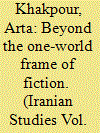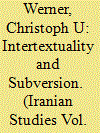| Srl | Item |
| 1 |
ID:
144723


|
|
|
|
|
| Summary/Abstract |
The debate over political commitment in Iran was never limited to adjudicating content: it was frequently a debate over form as well. In the realm of fiction, this debate fixated on realism, the nature of mimesis, and the autonomy of art and the literary text. Within a few short years after forming the iconoclastic journal Jong-e Esfahan in 1965 with a group of likeminded colleagues, the writer Hushang Golshiri had become the preeminent modernist fiction writer in Iran. His critical essays represented a passionate defense of aesthetic autonomy at a time when realism and, particularly, socialist and “engaged” literature were powerful shibboleths in the Tehran literary scene. This paper begins with a look at Golshiri's critical interventions in this debate and then moves on to show how the short stories he produced in the Jong era were an even more integral part of his response to the mimesis question. By reading his stories with a methodology drawn from “possible worlds” theories of narratology, Todorov's fantastic, and Golshiri's own theories, we see how these works break down the “one-world” frame of reality that realism takes for granted, and require the reader to grapple with multiple, often contradictory, possible realities in its stead.
|
|
|
|
|
|
|
|
|
|
|
|
|
|
|
|
| 2 |
ID:
186905


|
|
|
|
|
| Summary/Abstract |
This study proposes an innovative, triangular close reading of three Persian authors: Nezāmi, Golshiri, and Mandanipour. It argues that the two modern authors, Hushang Golshiri with his famous novella Shāh-e siyāhpushān, the “King of those clad in black,” and Shahriar Mandanipour in his Censoring an Iranian Love Story, are not only bound to each other in a close master-disciple relationship, but also consciously expound on the subversive potential of the twelfth-century poet Nezāmi. In the process, the divide between modern and classical narrative traditions in Persian literature is bound to disappear, allowing for novel interpretations and perspectives on Nezāmi and for his epics to be heard.
|
|
|
|
|
|
|
|
|
|
|
|
|
|
|
|